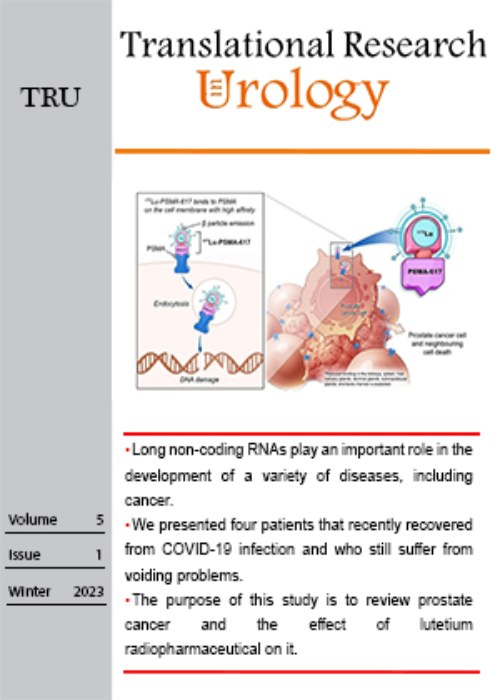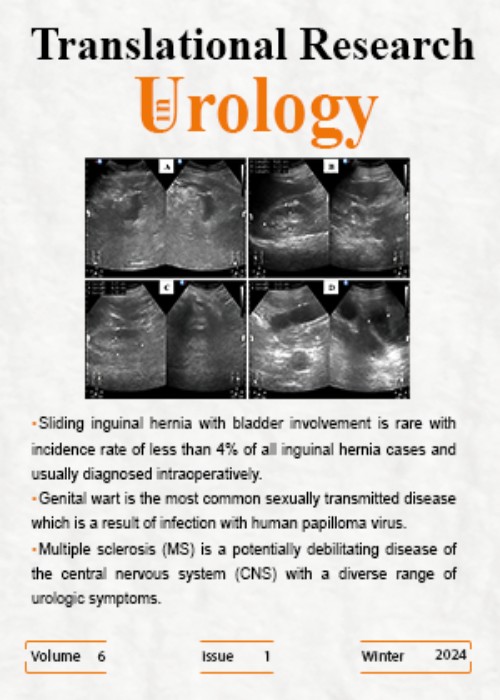فهرست مطالب

Journal of Translational Research in Urology
Volume:5 Issue: 1, Winter 2023
- تاریخ انتشار: 1402/01/10
- تعداد عناوین: 8
-
-
Pages 1-3Long non-coding RNAs (lncRNAs) are a group of noncoding RNAs longer than 200 nucleotides that don’t provide instructions for making proteins. LncRNAs have attracted widespread attention recently as a potentially novel and vital layer of biological regulation. All long non-coding RNAs are involved in a wide range of developmental and biological processes, but their action mechanisms are still unclear. The aim of this study was to review cutting-edge data on lncRNAs and discuss their known biological function.Keywords: lncRNA, cancer, Biological Function
-
Pages 4-8Introduction
COVID-19 is a disease that emerged in the last days of 2019. This viral disease can cause broad-spectrum symptoms and complications, but most patients experience mild to moderate symptoms with no severe complications. Lower Urinary Tract Symptoms (LUTS) contain many urinary problems. The symptoms can be caused by storing problems or voiding problems.
Case presentationThere are so many etiologies for each type of symptom. One of the most severe urinary complications is urinary retention, which can be caused by a viral disease. Recently we found patients in our clinic with urinary retention, and the only thing they had in common was their recent history of contracting the coronavirus. We started to follow them with some urinary tract functional tests and imaging.
ConclusionIn this study, we present four gentlemen with a recent history of COVID-19 and urine passage complications, which can be detected as urinary retention. We claim that this condition can be caused by the history of COVID-19, although we think much more studies are needed to prove that and find the exact mechanism.
Keywords: underactive bladder, COVID-19, lower urinary tract symptoms, case series -
Pages 9-15Introduction
Prostate cancer is a type of disease in which malignant cells originate from prostate tissue and multiply irregularly and increasingly, leading to an increase in volume in each of the cellular components of the prostate gland.
MethodsThe search for studies published in Google Scholar, PubMed, ProQuest, Science Direct, and Elsevier sites was performed with the keywords prostate, radiopharmaceutical, cancer, and Lutetium.
ResultsThe synthesis of articles related to prostate cancer and lutetium drug showed that the average prevalence of this complication and follow-up of its treatment in Iranian articles with the Beck tool is 52.13%, and in foreign articles, equal to 78.21%.
ConclusionsWith the help of remarkable advances in bioinformatics & molecular methods, much information has been obtained that will help in the early recognition of cancer, and timely screening for some cancers helps in its early diagnosis. In general, today, scientists have concluded that they can get the best result by early diagnosis and complete removal of cancer cells before the spread of cancer. Prostate cancer is the most common type of cancer in men over the age of 50. Currently, researchers are unable to determine the exact cause of prostate cancer. DNA changes can be hereditary or caused by certain lifestyles that people have chosen. Lutetium-177 Prostate-specific membrane antigen (PSMA), also called a prostate membrane-specific antigen, is becoming a popular treatment for men with advanced prostate cancer with metastatic (spread) or refractory tumors. This treatment method has successfully reduced the size of tumors (cancerous masses) in many patients. Lutetium-177 PSMA treatment (abbreviated as Lutetium) is a suitable treatment option for men undergoing radical prostatectomy or primary radiation therapy but still have disease recurrence and metastasis symptoms.
Keywords: Cancer Prostate, Lutetium, Prostate Specific Membrane Antigen -
Pages 16-27IntroductionThe association between the Altmetric Attention Score (AAS), a surrogate of public attention, and citation in urology cancer field articles was evaluated.MethodsWe searched in Scopus based on the existence of the following terms in the title, abstract, and keywords: prostate or bladder or kidney or renal or testis, AND tumor or cancer or malignancy, and the top 50 articles of 2015 with the highest citation counts were enrolled in our study. AAS was calculated using Altmetric explorer, and the citation number was extracted from Scopus.ResultsAt last, 23 irrelevant articles were excluded, and 27 remained. The article with the highest citation was placed 11th in the AAS ranking, and the article with the highest AAS was the 12th highly cited article. AAS had a significant association with citation count; however, it did not associate with journals' impact factor, study type, study topic, articles access, type of tumor, and geographic distribution (P-value>0.05). Most articles were original, mainly with "molecular mechanism and genetics" topics, and originated from USA institutions. Moreover, many were published in open-access journals and dedicated to prostate cancer.ConclusionArticles with fabulous citation counts do not necessarily have a higher Altmetric score, which indicates that subjects with high popularity among people may not interest the scientific community.Keywords: prostate, Bladder, Kidney, Testis, cancer, Altmetric
-
Pages 28-32IntroductionTo evaluate the effect of opiate addiction on the occurrence of staghorn renal stones.MethodsIn a case-control study from January 2020 to April 2020, sixty-three patients with staghorn renal stones enrolled in our study and compared with the 60 healthy patients. The exclusion criteria were age <18 years, single kidney, renal anomalies, and previous history of malignancy. The primary demographic data, including age, sex, educational status, smoking history, and nonmedical opium utilization, were compared between the two groups.ResultsThe incidence of staghorn kidney stones was significantly higher in males than females (45; 71.4 % male vs. 27;45.0 % P-value=0.003) respectively. There was no significant difference regarding smoking status between the patients with a staghorn kidney stone and the control group (14;22.2 % vs. 15;25.0 % P-value=0.717). The prevalence of addiction in patients with staghorn kidney stones was significantly higher than in the control group (30 patients; 46.2% vs. 7 patients;11.7 %, P-value<0.001). In the case group, fifty patients (79.4%) were undergraduates compared to 28 patients (46.7%) in the control group (P-value<0.001).ConclusionOur study represents higher proportions of men and uneducated persons with staghorn renal stones. Nonmedical Opiate addiction could be considered a risk factor for staghorn kidney stones.Keywords: urolithiasis, Staghorn Stone, Struvite Stone, opium addiction
-
Pages 33-40
Introduction:
The present study was a comprehensive study that assessed the effects of exposure to mobile phone radiation on body weight and body composition as well as assessing the critical indicators associated with body composition.
MethodsTwenty rats weighing 200+10g at 4 to 6 weeks of age were individually housed in cages. The rats were randomly divided into the following two groups of 10 animals each: the control group and an exposure group that underwent electromagnetic wave radiation for 4 hours once a day for five weeks. The exposure was given by mobile phone having a specific absorption rate (SAR) of 0.90 watts/kg.
ResultsThere were no significant differences in mean changes in weight, height, lee index, and chest between the two groups. No significant differences were detected in fat mass, lean mass, and total mass of exposure and control groups at the end of the study. There were no significant differences among groups in FBS, lipid profile, thyroid hormone, kidney function, and appetite-regulating hormones.
ConclusionsThe current study showed that exposure to mobile phone radiations for 4 hours once a day for five weeks (SAR of 0.90 Watt/kg) has no adverse effects on the thyroid, kidney functions, and hormonal profiles as well as body weight and body composition.
Keywords: Mobile Phone, Cell phone, Weight, Body mass index, body composition -
Pages 41-50IntroductionPercutaneous nephrolithotomy has obtained the mainstay role as a procedure of gold standard in patients harboring renal lithiasis larger than 2 cm. It has earned an outstanding reputation as a low complications/low mortality minimally- invasive procedure worldwide. Therefore, its complications carry a great deal, and considering bleeding as its main problem, possible post-bleeding Acute Renal Injury must be checked out.MethodsThis is a cross-sectional study planned for 91 patients who underwent PCNL. The renal Function variable had been tuned primarily as Serum Creatinine levels, which had been obtained before surgery following afterwards sessions as the order of days 1, 2, and 30 after surgery.ResultsDemographic data were as Gender: 63(69.2%) males. The mean age of the patients was 47.8± 4.7 years. Analytic Data as Mean stone size was 25 mm, Serum sodium & potassium & hemoglobin & hematocrit level &GFR. Data analysis uttered the considerable rise in the creatinine levels on the second day (p value<0.05), although respecting its levels after 1 month, all recovered in one month and meant no considerable decline neither in GFR or other biochemical levels.ConclusionOur Data revealed a considerable decrease in the overall kidney function through an increase in the serum creatinine and electrolytes levels on the second postoperative day which was shown to be completely recovered based on their measured levels after one month.Keywords: PCNL, Percutaneous nephrolithotomy, AKI, Acute Renal Injury, Creatinine, GFR
-
Pages 51-58IntroductionThis investigation aims to assess and compare the effect of cigarettes and e-cigarettes on the expression of TERT, FGFR3, PTEN, P53, and VEGF in rat bladder.Methods60 Wistar rats were classified into three groups (10): Group A (Control), Group B: case (cigarette smoke), and Group C: case (E-cigarette smoke). The rats were exposed to cigarettes or e-cigarettes for 10 minutes. These 10 minutes were performed three times a day, and in total, the samples were exposed to cigarettes or e-cigarettes for 40 minutes a day with 1-hour rest for 16 weeks.ResultsHistopathological findings showed cigarette-induced hyperplasia and e-cigarette-induced hyperemia and infiltration of inflammatory cells. The expression of FGFR3, TERT, and VEGF genes significantly increased and the expression of the PTEN gene significantly decreased in both cigarette and e-cigarette groups in both male and female rats compared to the control group but these changes were not significant between the two groups. The expression of P53 decreased in both groups, but the female rat in the e-cigarette significantly increased.ConclusionWe found that both groups changed the expression of genes involved in the development of BC, but no differences were found two groups. Therefore, the e-cigarette is not an excellent alternative to cigarettes.Keywords: Bladder Cancer, E-cigarettes, Rat, Gene expression


